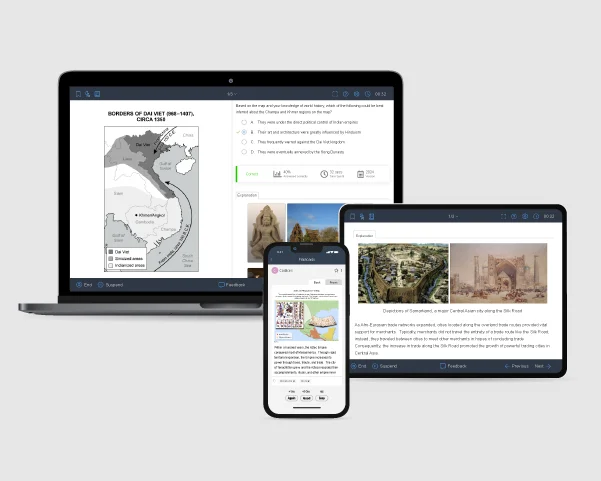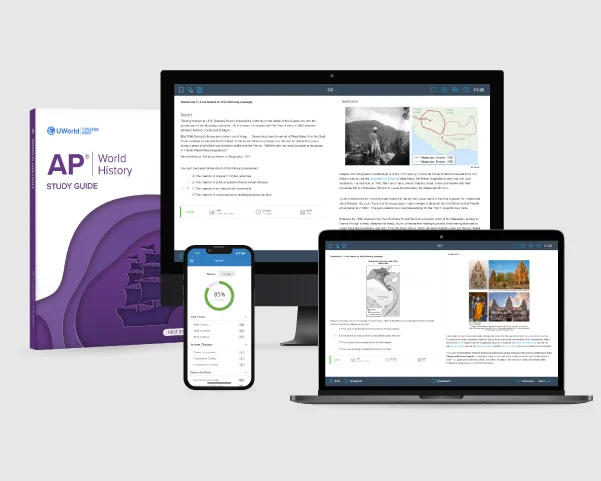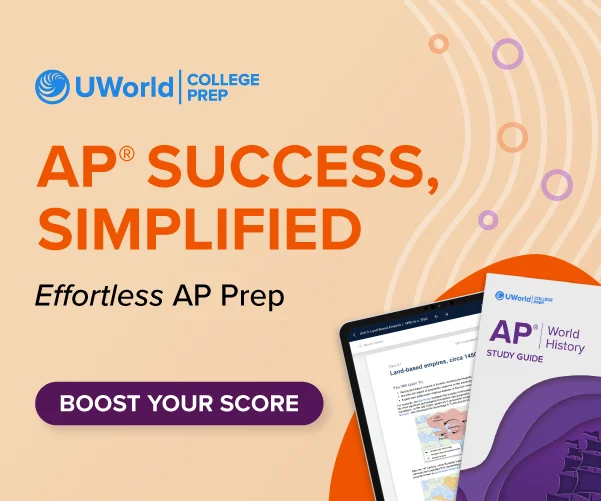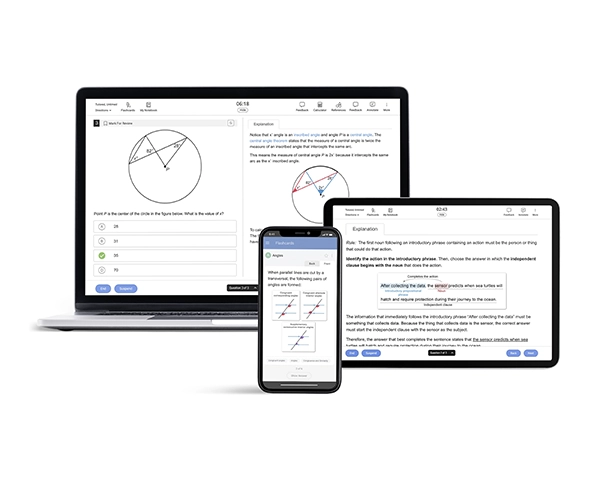There is 1 Continuity and Change Over Time (CCOT) essay on the AP World History exam. It requires you to analyze historical continuity and change over time within a specific period. You will be asked to write on either continuity or change but will receive a complexity point for writing about both.
Understanding the CCOT Essay Prompt
The CCOT essay helps you understand long-term trends and the factors influencing historical development. To craft a strong CCOT essay, you will have to recognize patterns of change and continuity, use relevant historical evidence, and construct a clear, defensible thesis.
Example LEQ prompt:
Develop an argument that evaluates the extent to which long-distance migrations from Europe to the United States changed from 1700 to 1900.
Writing a high-scoring LEQ AP World History essay requires a clear structure, a well-developed thesis, and strong supporting evidence. Let's break down the steps to help you craft a compelling response.
Analyze the Prompt
This prompt asks you to write about change.
Once you have analyzed the prompt and decided that answering the question using continuity and change over time historical skills is best, come up with 2 or 3 changes that occurred during the era in the prompt.
Example:
Two regions: Europe and the Americas.
Changes:
- Rise in indentured servitude
- Rise in Irish immigration
- Continuity (for the complexity point):
- Determine 1 continuity from the era mentioned in the prompt. For example, immigrants continued to flow into the U.S., searching for economic gain.
Establish Context
Context (1 point on both the document-based question (DBQ) and long essay question (LEQ)):
From your knowledge of this historical period, you should analyze how long-distance migrations changed.
How to provide context:
- Situate the argument by explaining broader historical events, developments, or processes relevant to the question.
- Provide historical background for the argument.
- Set the scene with at least 2-3 sentences in the introduction.
Think of contextualization like a TV show: At the beginning of an episode, the producers show scenes from previous episodes to set the stage. This is the historical context.
Brainstorm and Analyze
Brainstorming: Think about the changes or continuities that were decided on.
Questions to Consider:
- Why did the change occur, and what evidence supports it?
- Why was there a rise in indentured servitude?
- Why was there a rise in Irish migration?
- Why did the continuity occur, and what evidence supports it?
- Why did immigrants continue to flow into the U.S. during this era, searching for economic gain?
Analyzing these elements will help you write your thesis statement and develop a strong essay.
Write the Thesis Statement
The thesis is the main argument of the essay. According to the AP World History rubric, you must provide a historically defensible thesis establishing a reasoning line.
Tips for writing a strong thesis:
- Think of it as a road map for the essay.
- The thesis should be clearly stated in either the introduction or conclusion.
Example:
"From 1700 to 1900, there were many changes in long-distance migrations to Europe and the Americas. Changes included the rise in indentured servitude and Irish migration. One continuity during this period was the continued flow of immigrants to the U.S. searching for economic wealth."
Ensure your thesis is specific, historically defensible, and directly answers the prompt for a top score.
Write the Essay
Now that you've analyzed the prompt, established context, and developed a strong thesis, it's time to put everything together. The essay should follow a clear structure, beginning with an introduction and progressing through body paragraphs that address changes, continuities, and supporting evidence before concluding with a strong final paragraph.
How to Structure Your CCOT Essay
Here's how to structure your essay to score the highest possible points:
Introduction Paragraph
- Provide context (historical background that ties into the prompt).
- State the thesis (respond to the prompt with a specific historically defensible claim), either at the beginning or the end of the paragraph.
- Beginning of the Paragraph: Placing your thesis statement at the very start can help readers quickly grasp your focus and guide your writing, but it could also potentially feel abrupt without a brief introduction or contextual lead-in.
- End of the Paragraph: Placing your thesis statement at the end of the introduction can allow for background context and a natural lead-in to your argument, but it could also potentially delay clarity and risk losing immediate reader focus.
Questions to Consider:
- Does the historical context tie into the prompt?
- Did you mention continuities/changes in the thesis?

Body Paragraph #1: Changes – Rise in Indentured Servitude
- Historical Reasoning: Start with the topic statement summarizing the major change.
- Provide specific examples
- Economic demand for labor
- Migration of European workers
- Cite supporting evidence: Explain why this change occurred.
Questions to Consider:
- What are the changes?
- Did you give specific examples and analyze why they occurred?
- Did you provide descriptive evidence?
Body Paragraph #2: Changes – Rise in Irish Migration
- Historical Reasoning: Start with the topic statement summarizing the major change.
- Provide specific examples
- Potato famine in Ireland
- Job opportunities in the U.S.
- Cite supporting evidence: Explain why this change occurred.
Questions to Consider:
- What are the changes? (Tip: Try drawing a quick Venn diagram to help with this and focus on the areas of the model that do not overlap.)
- Did you give specific examples and analyze why they occurred?
- Did you provide descriptive evidence?
Body Paragraph #3: Continuities (Complexity Point)
- Historical Reasoning: Start with the topic statement summarizing the major continuity.
- Provide evidence: Explain why immigration to the U.S. continued during this period.
Questions to Consider:
- What are the continuities? (Tip: If you choose to discuss continuities, a quick Venn diagram can also help you focus on that content by honing in on the overlapping part of the model.)
- Did you give specific examples and analyze why they occurred?
- Did you provide descriptive evidence?
Conclusion Paragraph: Bring It All Together
- Reaffirm the thesis by explaining how the evidence supports the argument.
Mastering the LEQs on the AP World History exam requires careful analysis, strong historical reasoning, and effective writing strategies. By following these steps, you can craft well-structured essays that clearly communicate your argument.
Questions to Consider:
- Did your evidence support the thesis?
- Did you answer the prompt fully?
AP World History Essay Writing Checklist`

References
- (2011). 2011 AP® WORLD HISTORY FREE-RESPONSE QUESTIONS. College Board. Retrieved on January 29, 2025 from https://secure-media.collegeboard.org/apc/ap11_frq_world_history.pdf
- (n.d.). Irish Emigration to America. Museum. Retrieved on January 30, 2025 from https://www.museum.ie/en-IE/Collections-Research/Folklife-Collections/Folklife-Collections-List-(1)/Other/Emigration/Irish-Emigration-to-America#:~:text=The%20peak%20of%20Irish%20emigration,830%2C%20between%201841%20and%201851.
- (n.d.). Industrialization, Labor, and Life. National Geographic. Retrieved on January 30, 2025 from https://education.nationalgeographic.org/resource/industrialization-labor-and-life/






